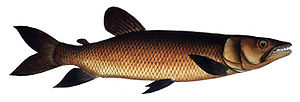Hepsetus odoe
| Hepsetus odoe | ||||||||||||
|---|---|---|---|---|---|---|---|---|---|---|---|---|

Hepsetus odoe |
||||||||||||
| Systematics | ||||||||||||
|
||||||||||||
| Scientific name | ||||||||||||
| Hepsetus odoe | ||||||||||||
| ( Bloch , 1794) |
Hepsetus odoe is a predatory fish found in western Africa. Its habitat ranges from the Ivory Coast to the Shari in the Central African Republic .
features
Hepsetus odoe has an elongated, pike-like body, covered by cycloid scales , 30 to 60 centimeters long. It is hardly flattened on the sides and has a flat top on the head. Its maximum weight is given as four kilograms. The muzzle is long, the mouth large and occupied by some very large, conical and rearward-facing fangs and smaller, pointed teeth. There are sail-like attachments on the jaw that may be sensory organs . The top of the fish is brownish, the flanks and belly are silvery with a clay-yellow tinge. The eyes are large and brass-colored, the nostrils are close together. They have a red-orange spot above the eyes, behind which there are some light and dark bands. The fins are pink to gray, the dorsal fin has some brown-red rays, the adipose fin is black. Adult animals can have black spots on the paired fins. The anal fin lies behind the dorsal fin. Hepsetus odoe has 45 to 49 vertebrae . There are 49 to 60 scales along the lateral line organ .
- Fin formula : dorsal II / 7–9, anal II / 9–11.
- Scale formula : mLR (49) 50–60.
Hepsetus odoe is relatively short-lived and only lives four to five years old.
Way of life
Hepsetus odoe is a migratory fish , lives in rivers, lakes and swamps and tends to stay on the bottom of the water. It prefers calm, deep waters with a pH value of 6 to 7.5 and a water hardness of up to 18 ° dH. Adult animals eat fish, young fish mainly live in heavily vegetated habitats and feed on smaller fish and invertebrates. The pike tetra multiply in the summer months and lay the eggs in a foam nest floating on the surface of the water, which is guarded by one or both parents.
use
Hepsetus odoe is caught with nets and used as food fish. The meat is reddish and is considered to be tasty. The species is of no importance in the aquarium hobby, as they are very sensitive and die with the smallest of injuries.
literature
- Joseph S. Nelson : Fishes of the World . John Wiley & Sons, 2006, ISBN 0-471-25031-7 .
- Günther Sterba : The world's freshwater fish. 2nd Edition. Urania, Leipzig / Jena / Berlin 1990, ISBN 3-332-00109-4 .
- E. Decru, E. Vreven, J. Snoeks: A revision of the West African Hepsetus (Characiformes: Hepsetidae) with a description of Hepsetus akawo sp. nov. and a redescription of Hepsetus odoe (Bloch, 1794). In: Journal of Natural History. Volume 46, No. 1-2, Jan 2012, pp. 1-23. doi: 10.1080 / 00222933.2011.622055 .
- E. Decru, J. Snoeks, E. Vreven: The true identity of the holotype of Hepsetus odoe and the names of the two West African species of Hepsetus (Teleostei: Hepsetidae). In: Ichthyological Exploration of Freshwaters. Volume 24, No. 2, 2013, pp. 187-192.
Web links
- Hepsetus odoe on Fishbase.org (English)
- Hepsetus odoe inthe IUCN 2013 Red List of Endangered Species . Posted by: Entsua-Mensah, M., Lalèyè, P., Marshall, B., Moelants, T. & Tweddle, D., 2009. Retrieved January 9, 2014.